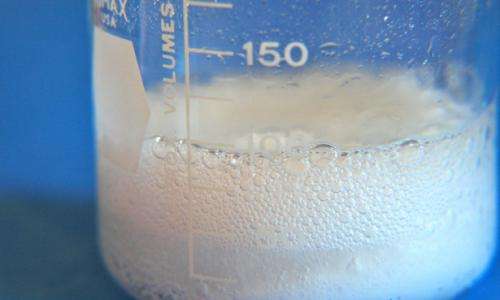Are There Pastries That Can Be Made With Out Baking Powder or Baking Soda

What's the departure between baking soda and blistering pulverization? Curt respond: acid. But information technology can brand a big divergence for broiled goods, so let's explain.
Baking soda has merely ane ingredient: sodium bicarbonate. Sodium bicarbonate is a base of operations that reacts when it comes into contact with acids, like buttermilk, yogurt or vinegar. This reaction produces carbon dioxide (CO2) in the form of bubbling, like a liquid foam (recall of the class school experiments involving false volcanoes, vinegar and baking soda). When making broiled goods, the process is called "chemical leavening," because the trapped CO2 gas makes the dough or batter ascension.
Simply when baking soda comes into contact with an acid, it pretty much reacts immediately. And that's a problem.
For many baking recipes, you desire an extended reaction, so that the rising doesn't take place all at once.
Baking powder addresses this problem considering it is "double interim" – it has different ingredients that create CO2 gas at unlike stages of the baking process.
All baking powders contain sodium bicarbonate (just like baking soda). Just baking powder as well contains two acids. I of these acids is chosen monocalcium phosphate. Monocalcium phosphate doesn't react with the sodium bicarbonate while it's dry. Just equally before long as the baking powder is stirred into a moisture dough or batter, the two ingredients begin to react, releasing bubbling of CO2 and causing chemical leavening.
But to extend the chemical leavening procedure, baking pulverisation also contains a second acid, either sodium acid pyrophosphate or sodium aluminum sulfate. Neither of these acids react with sodium bicarbonate until they are both: A) wet (i.e., stirred into the concoction) and B) hot.
In other words, sodium acid pyrophosphate and sodium aluminum sulfate won't start reacting with the sodium bicarbonate until afterwards you've put the dough or concoction in the oven. This ways that the batter rises for a longer menstruum of time, making lots of bubbling (and a fluffier block, muffin, or whatever).
At some point during the baking process, the liquid foam of rising batter becomes a solid foam, because the batter "sets." This is one reason eggs are so common in baking recipes.
The proteins in eggs become irreversibly denatured when exposed to heat (i.e., the proteins unfold and cannot refold into their original shape). These altered egg proteins substantially give the liquid foam a solid construction, assuasive it to agree its shape.
By comparing, in recipes that use yeast as a leavening agent, the gluten proteins in flour serve a role similar to that of egg proteins in most chemically-leavened baked goods in the sense that they aid to trap air bubbles until the dough sets. (That's why bread flour has more protein than cake flour.)
Commendation: The difference between blistering soda and blistering pulverisation (2014, May 22) retrieved xvi February 2022 from https://phys.org/news/2014-05-deviation-soda-pulverisation.html
This document is subject to copyright. Autonomously from any fair dealing for the purpose of private study or research, no part may be reproduced without the written permission. The content is provided for information purposes only.
Source: https://phys.org/news/2014-05-difference-soda-powder.html
0 Response to "Are There Pastries That Can Be Made With Out Baking Powder or Baking Soda"
Post a Comment